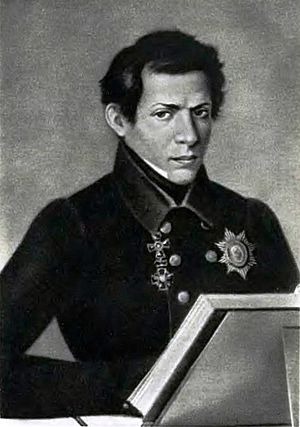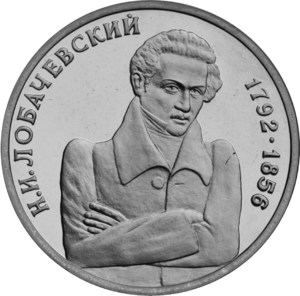Nikolai Lobachevsky facts for kids
Quick facts for kids
Nikolai Lobachevsky
|
|
|---|---|
| Никола́й Лобаче́вский | |

Portrait by Lev Kryukov, c. 1839
|
|
| Born | 1 December 1792 Makaryev, Makaryevsky uezd, Nizhny Novgorod Governorate, Russian Empire (now Makaryevo, Nizhny Novgorod Oblast, Russia)
|
| Died | February 24, 1856 (aged 63) |
| Education | Kazan University (MSc, 1811) |
| Known for | Lobachevskian geometry |
| Scientific career | |
| Fields | Geometry |
| Academic advisors | J. C. M. Bartels |
| Notable students | Nikolai Brashman |
| Signature | |
Nikolai Ivanovich Lobachevsky (Russian: Никола́й Ива́нович Лобаче́вский, IPA: [nʲikɐˈlaj ɪˈvanəvʲɪɕ ləbɐˈtɕɛfskʲɪj]; born December 1, 1792 – died February 24, 1856) was a famous Russian mathematician. He is best known for his amazing work on a special type of geometry called hyperbolic geometry. This is also known as Lobachevskian geometry. He also made important studies on Dirichlet integrals, which are a part of advanced math.
A mathematician named William Kingdon Clifford once called Lobachevsky the "Copernicus of Geometry." This means his work was as revolutionary for geometry as Copernicus's ideas were for astronomy.
Contents
Life Story of Lobachevsky
Nikolai Lobachevsky was born in 1792 in the Russian Empire, near the city of Nizhny Novgorod. He was one of three children. When he was seven, his father, who worked in a land-surveying office, passed away. Nikolai then moved with his mother to Kazan.
Education and Early Career
Nikolai Lobachevsky went to Kazan Gymnasium from 1802 to 1807. After that, he received a scholarship to Kazan University, which had just opened in 1804.
At Kazan University, Lobachevsky was taught by Professor Johann Christian Martin Bartels. Bartels was a former teacher and friend of the famous German mathematician Carl Friedrich Gauss. In 1811, Lobachevsky earned his Master of Science degree in physics and mathematics.
He quickly moved up in his career at the university. In 1814, he became a lecturer. By 1816, he was an associate professor. In 1822, at the age of 30, he became a full professor. He taught mathematics, physics, and astronomy.
Leadership at the University
Lobachevsky held many important jobs at Kazan University. In 1827, he became the rector, which is like being the president of the university.
In 1832, he married Varvara Alexeyevna Moiseyeva. They had many children, though only seven lived to adulthood. He left the university in 1846. By the early 1850s, he was almost blind and could not walk well. He passed away in 1856 and was buried in Arskoe Cemetery in Kazan.
Lobachevsky's Amazing Work in Geometry
Lobachevsky's biggest achievement was creating a new kind of geometry. He did this on his own, at the same time as another mathematician named János Bolyai. This new geometry is now called non-Euclidean geometry or Lobachevskian geometry.
Understanding Euclid's Fifth Postulate
Before Lobachevsky, mathematicians had been trying to prove one of Euclid's rules, called the fifth postulate. This rule is about parallel lines. In simple terms, it says: if you have a straight line and a point not on that line, you can draw only one line through that point that will never cross the first line (it will be parallel).
Mathematicians thought this rule should be provable from Euclid's other, simpler rules. But no one could prove it.
Creating a New Geometry
Instead of trying to prove the fifth postulate, Lobachevsky decided to imagine a geometry where this rule was not true. He explored what would happen if you could draw more than one line through a point that would be parallel to another line. This was a very bold and new idea!
He first shared his ideas in 1826. His research was later printed in 1829–1830. He also wrote a paper called "A Concise Outline of the Foundations of Geometry."
What is Hyperbolic Geometry?
The non-Euclidean geometry that Lobachevsky developed is called hyperbolic geometry. In this geometry, if you have a line and a point not on it, you can draw many lines through that point that will never cross the first line.
In hyperbolic geometry, the angles inside a hyperbolic triangle (a triangle drawn on a curved surface) always add up to less than 180 degrees. This is different from the flat geometry we learn in school, where angles in a triangle always add up to exactly 180 degrees.
Lobachevsky's ideas helped lead to the development of differential geometry, which has many uses in science and engineering. Hyperbolic geometry is often called "Lobachevskian geometry."
Who Discovered Hyperbolic Geometry?
Some people mistakenly thought that Lobachevsky was influenced by Gauss in his work. However, this is not true. Gauss admired Lobachevsky's work, but they never talked about it before Lobachevsky published his ideas.
Even though three people—Gauss, Lobachevsky, and Bolyai—all thought about hyperbolic geometry, Lobachevsky was the first to share his ideas with the world of mathematicians.
Other Contributions
Lobachevsky also wrote many important books on geometry, including New Foundations of Geometry (1835–1838) and Pangeometry (1855).
Another of his achievements was creating a way to find the roots (solutions) of algebraic equations. This method is now known as the Dandelin–Gräffe method. In Russia, it is called the Lobachevsky method. He also gave a clear definition of a function in mathematics.
Impact and Recognition

Lobachevsky's work was revolutionary. It changed how mathematicians thought about space and geometry. His ideas were very important for the future of mathematics and physics.
Honors and Legacy
Many things have been named in honor of Nikolai Lobachevsky:
- 1858 Lobachevskij, an asteroid discovered in 1972.
- The lunar crater Lobachevsky on the Moon.
- The Lobachevsky Prize, a mathematics award given by Kazan State University.
- The Lobachevsky University in Russia.
Major Works by Lobachevsky
Here are some of Lobachevsky's important writings:
- Geometrical Researches on the Theory of Parallels (1840)
- On the Origin of Geometry (1829–30)
- New Principles of Geometry with Complete Theory of Parallels (1835–38)
- Imaginary Geometry (1835)
- Pangeometry (1856)
- English translations of his works
- Geometrical Researches on the Theory of Parallels (1891)
- Pangeometry (excerpts translated by Henry P. Manning)
- New Principles of Geometry with Complete Theory of Parallels (1897)
- Pangeometry, translated and edited by A. Papadopoulos (2010)
See also
 In Spanish: Nikolái Lobachevski para niños
In Spanish: Nikolái Lobachevski para niños
- 1858 Lobachevskij
- Hyperbolic geometry
- Non-Euclidean geometry
- Lobachevsky (crater)
- Lobachevsky function
- Lobachevsky Medal
- Lobachevsky University

